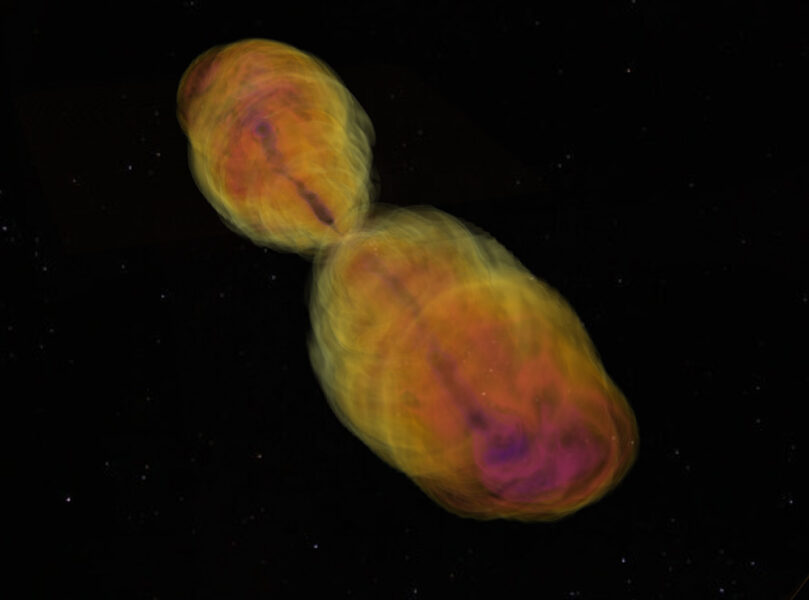A recently discovered type of stellar explosion might fit right in among supernovae and gamma-ray bursts.

Ore Gottlieb / Northwestern University
Less than four years after astronomers first discovered a new and puzzling type of stellar explosions, they may have solved the riddle of the objects’ true nature. According to Ore Gottlieb (Northwestern University) and colleagues, fast blue optical transients (FBOTs) are exploding stars more or less intermediate between regular supernovae and long gamma-ray bursts.
The mystery first surfaced in June 2018, when a robotic telescope picked up a sudden outburst in the spiral arm of a remote galaxy. Cataloged as AT2018cow (and nicknamed “The Cow”), the flash was both briefer and about 10 times more luminous than the average supernova. Spectroscopic observations revealed the presence of large amounts of hydrogen and helium, as well as outflow velocities at 10% of the speed of light. While its visible-light emission quickly faded, The Cow produced radio waves and X-rays at later stages of its cosmic performance.
A handful of similar FBOTs have been observed since, and creative theorists came up with a wide variety of possible explanations, including the collision of two white dwarf stars; the merger of a giant star and a compact neutron star; and a tidal disruption event, in which a star is devoured by an intermediate-mass black hole.
Meanwhile, follow-up observations of The Cow by the NICER X-ray telescope have hinted at the presence of a leftover neutron star or a black hole, suggesting a possible link with supernovae or gamma-ray bursts (GRBs), the explosions of massive stars. Theorists had proposed similar models, but none had explained all the observations.
Gottlieb, together with Alexander Tchekhovskoy (also at Northwestern) and Raffaella Margutti (University of California, Berkeley), now describe a detailed scenario that can “naturally explain the entire set of FBOT observables”, as they write in the April 11th Monthly Notices of the Royal Astronomical Society (free preprint available).
“It’s a beautiful model,” comments astrophysicist Ralph Wijers (University of Amsterdam).
Regular supernovae are more or less spherically symmetric. The energy released by the collapsing star is distributed over a huge amount of stellar material, moderating the explosion. If, on the other hand, the progenitor star is massive, rotating rapidly, and has lost most of its hydrogen and helium mantle, the collapse launches two jets into interstellar space. Released in opposite directions along the star’s rotational axis, these jets produce the extremely high-energy fireworks of a long GRB.
According to Gottlieb, Tchekhovskoy, and Margutti, FBOTs fill the gap between these two explosive scenarios. In FBOTs, the progenitor’s collapsing core is spinning fast enough to produce jets, just like in GRBs. But for some reason, the star has retained its massive hydrogen and helium envelope, which “smothers” the jets so that they’re unlikely to penetrate all the way to the star’s surface. Instead, two massive cocoons of stellar gas pile up around the jets’ heads; these cocoons are eventually blown into space at about 10% of light speed.
The sudden emergence of the jet-driven cocoons and their subsequent cooling neatly explains the rapid changes astronomers see in FBOTs’ visible light, the authors argue. Their interaction with surrounding circumstellar material produces radio waves. And when the debris of the exploding star expands far enough, X-rays from the central remnant (either a neutron star or a black hole) can leak out into space. “Our model is able to draw a line among supernovae, GRBs and FBOTs, which I think is very elegant,” Gottlieb said in a press statement.
Wijers is one of the theorists who believed from the start that FBOTs “might well fill in part of the gap” between regular supernovae and gamma-ray bursts. “But that was something of a hand-waving argument,” he says. “This new paper is a solid piece of theoretical underpinning, both analytical and through computer simulations, that really shows it could work.”
Then again, he points out that there’s more work to do: while the new model predicts the rapid fading of The Cow’s visible light, it doesn’t do so to the same extent as was observed. Future observations of additional FBOTs, many of which are expected to be found by the upcoming Vera C. Rubin Observatory, will hopefully add to an even better understanding of these rare explosive beasts.
 0
0









Comments
You must be logged in to post a comment.